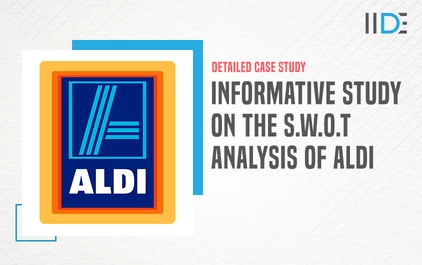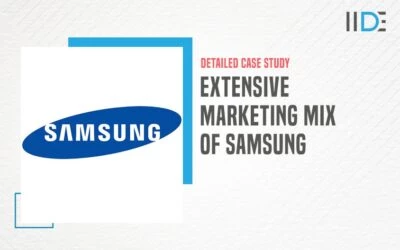In this blog, we will be discussing the SWOT Analysis of Aldi, those being its strengths, weaknesses, opportunities, and threats. So, let’s start with a quick introduction to the company.
About Aldi

Including Germany, the company has networks in the United States, Europe, UK, Australia, and China.
Quoted as Europe’s largest retailer by some, the firm founded its success by opposing virtually every standard of the supermarket, from its renowned distancing to the “Spartan atmosphere” of its stores. In the 1990s the company operated an estimated 3,000 stores.
Aldi’s business model is known as “limited-assortment” stores or “hard discounters” in the grocery business. Various products sold by Aldi include groceries, everyday household items, cosmetic products, domestic items, drinks, discounted buys, and garden products.
Now that we have a brief overview of Aldi, let’s peek into its SWOT analysis.
Swot Analysis of Aldi

A SWOT analysis is a strategic analysis tool that is used to analyze a company’s competitive positioning in the business world. Aldi figures out its Strengths (S) and Weaknesses (W) followed by the identification of the Opportunities (O) and Threats (T) which the company deals with in the competitive business era.
1. Strengths of Aldi
Strengths are nothing but the innovative and unique strategies used by the company. This helps the brand to be successful and profitable in all possible aspects.
Let’s see the strengths of Aldi in the coming section.
- Efficient Pricing of Key Assets
The company has automated various stages of production which results in more efficient use of resources and cost-cutting of products due to which chains of discount stores like Aldi can provide high-quality products at cheap and efficient prices to the customers when compared to the mainstream retailers which engage more customers and this gives them a pricing edge over other retailers.
- Solid Distribution Chain
Over all these years in the industry, Aldi has managed to build good relations with stakeholders. These relations, not Aldi, only ensure that there is no congestion in the supply chain and that its products are available easily to a large number of customers on time but also focus on promoting the company’s products and training. Its market presence in over 20 countries which includes 1600 stores in 11,234 areas helps for the same.
- Great Product Range and Consumer Satisfaction
Aldi provides a high level of consumer satisfaction to its buyers by providing huge deals on general household items which cover over 25% of its portfolio advertised through a strong social media presence. The company has several unique product offerings that are not provided by its competitors. Apart from food and drinks, the firm also sells other discounted products, ensuring that customers have a wide range of products to choose from, while the company enjoys a consistent stream of revenues.
2. Weaknesses of Aldi
Weaknesses are the basic hurdles faced by the company. Here are some of the weaknesses of Aldi mentioned below.
- Unethical Practices
Companies like Aldi are always dependent on its sales volume for profit, so sometimes the organization engages in unethical practices. Employees have to work extra hours with more shifts and are generally paid less.
- Small Market Share
Despite its huge growth in 2020, Aldi is still lagging behind big fishes in the game when market share is compared. 2020’s stats show that Tesco’s market share is 26.9%, subsequently, Sainsbury’s market share is 14.9%, Asda’s 14.4%, and Morrison’s 10.1%
- Brand Association
The company is often associated as a brand for inexpensive and low-grade items and is mostly preferred by low-wage families. It fails to cater to the middle class and high-class families, due to which its target audience becomes limited
3. Opportunities for Aldi
Opportunities are potential avenues for growth. Let’s discuss the opportunities of Aldi below.
- Further Expansion in Australia
Aldi has the ability to grow its market shares in Australia and surpass the massive two supermarkets behemoths of Australia Woolworths and Coles. Also, a new brand name in the Australian market has the opportunity to create strong ties among states and cities.

- Effect of Pandemic
Aldi’s earnings are likely to flourish continuously as the demand for food has increased drastically in this pandemic due to market uncertainties. A large number of customers are expected to get attracted to stores offering economical and budget pricing in this pandemic.
- Brand Marketing
To attract a larger audience Aldi should also start providing high-quality products with increased prices as the demand of the consumer is growing day by day. It should also finance more advertising to keep up with the competition.
4. Threats to Aldi
Threats are the hardships faced by the company. It needs to find new ways to overcome its threats in order to be in business. Let’s see some major threats to Aldi.
- Aggressive Competition
Aldi faces a lot of competition from market leaders like Walmart, Tesco, Best Buy, Lidl, and the Australian market also faces huge competition from Old Players, Woolworths and Coles.
- Emerging Technology
The growing industry of e-commerce jeopardizes the current market share of the retailing industry. For example, a large number of people nowadays prefer online shopping and deliveries rather than going to physical stores. It can lead to major shifts in market revenue.
- Global Instabilities
Aside from the emerging global crisis due to the pandemic, Europe is flustered by the repercussions of Brexit. Overnight changes like these not only pose a threat to Aldi but other retailers too.
Conclusion:
Aldi has its fair share of weaknesses and threats, but it can succeed in its market through capitalising on the opportunities mentioned above, especially geographical expansion. The company’s unique and innovative strategies that form its concrete strengths have worked in its favour so far, and if they continue on this path they’re sure to replicate it.
Thank you for reading our case study on Aldi SWOT Analysis. We hope you found what you were looking for. If you did, be sure to let us know your thoughts in the comments section below! If interested in Digital Marketing, check out IIDE’s Free Masterclass on Digital Marketing.







0 Comments